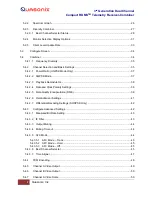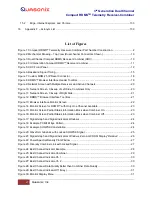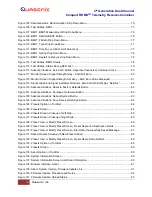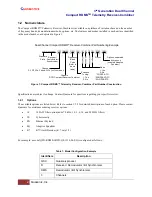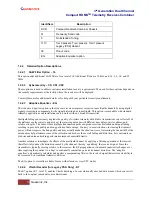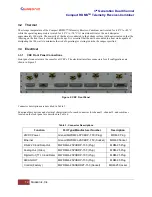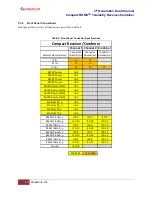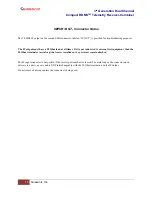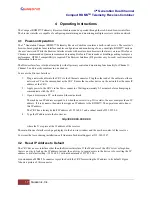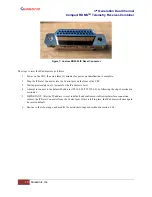
3
rd
Generation Dual Channel
Compact RDMS
TM
Telemetry Receiver-Combiner
3
Quasonix, Inc.
Identifiers
Description
RCD
Compact Receiver-Combiner Chassis
Q
Frequency band code
0
No Extended Tuning
1110
Tier 0 present, Tier I present, Tier II present,
Legacy (PSK) absent
00
Pinout code
EQ
Adaptive Equalizer option
1.2.2
Detailed Option Descriptions
1.2.2.1
SAW Filter Option
– 14
This option adds additional SAW filters, for a total of 14. Additional filters are 70 kHz, and 1.4, 3, 6, 14, and 28
MHz.
1.2.2.2
Cybersecurity
– CS, CS1, CS2
These options are used to address customer installation security requirements. The need for these options depends on
the security requirements at the facility where the receivers will be deployed.
Contact Quasonix for additional details or for help with your particular security requirements.
1.2.2.3
Adaptive Equalizer - EQ
The Adaptive Equalizer option in the Quasonix receiver improves reception in multipath channels by using digital
signal processing to compensate for the signal distortion due to multipath. This option is compatible with standard
telemetry applications and installations and it works with any brand of transmitter.
Multipath fading can seriously degrade the quality of wireless telemetry data. Radio transmissions can reflect off of
the airframe or other objects and arrive at the receiving antenna with different time delays, carrier phases, and
relative strengths. The sum of these multiple transmission paths can produce serious distortion and signal fading
resulting in poor data quality and long periods of data outage. Contrary to most situations, increasing the transmit
power will not improve the link quality and may actually make the situation worse. Narrowing the beamwidth of the
antenna may help eliminate some of the reflections and reduce the overall fading and distortion, but constraints on
dish size and antenna tracking performance impose beamwidth limits.
Another solution is to mitigate the effects of the multipath channel by applying a filtering operation at the receiver
that effectively undoes the distortion caused by the channel, thereby ‘equalizing’ the received signal. Since the
transmitter is typically moving relative to the receiver, the RF propagation environment dynamically changes over
time requiring the equalizer to ‘adapt’ to continually combat the perceived channel distortion. The ‘adaptive
equalizer’ automatically calculates and applies a compensating filter to the received signal that restores its ability to
be recovered by a traditional telemetry detector.
The EQ option is currently available for use with all modes
except
STC modes.
1.2.2.4
Viterbi Decoder (for Legacy PSK Only) - K7
The K7 option (k=7, rate 1/2) enables Viterbi decoding of a convolutionally encoded data stream, which converts it
back to the original (uncoded) source data stream.



